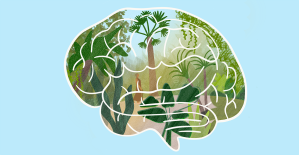
Anna Shchetinina.
Photos by Grace DuVal
‘Heartbreaking’ encounter inspired long view on alcohol
Student makes it her mission to detail effects of prenatal exposure
The woman came in crying. She was disheveled and pregnant, and appeared to be intoxicated. She had a 5-year-old girl in tow and was looking for help from the crisis center where Anna Shchetinina volunteered.
The mother got the help she needed. She sobered up, left her abusive partner, and eventually started a career in the medical field. Still, 15 years later, Shchetinina can’t stop thinking about the kids.
“One encounter changed everything for researcher who hopes to help mothers and families detect and treat the effects of dangerous drinking.”
“I didn’t realize then that the mother’s drinking was probably going to impact her children’s whole lives, but now I understand that every decision matters, especially during sensitive and critical periods,” she said. “Fetal alcohol spectrum disorder is a very unique condition. It is 100 percent preventable, but it’s incurable and has very drastic consequences: cognitive, behavioral, and physical.”
In April, Shchetinina published a study in the journal PLOS One examining the prevalence of alcohol use disorder among pregnant and parenting women. The work has provided a foundation for her doctoral studies at the Harvard T.H. Chan School of Public Health, where she’s examining the lifelong risks associated with prenatal alcohol exposure. Among the potential consequences is fetal alcohol spectrum disorder, whose most severe form is fetal alcohol syndrome.
In the worst cases of exposure, the mother loses her pregnancy. When the baby survives, the effects often go unnoticed until school age, when performance, behavior and even routines that children typically carry out independently — getting up in the morning, making the bed, putting on clothes — become a challenge. Over time, damage wrought by prenatal exposure to alcohol can affect memory, self-control, emotions, attention, and problem-solving.
“There are a lot of unknowns in this field. We are still just beginning to understand what its effects are on adult health: When people with prenatal alcohol exposure mature, what happens to them?”
“It’s usually diagnosed later, about when the child starts school and by that time it can be difficult to address,” Shchetinina said. “Diagnostics aren’t easy when so much time has passed. We might not get a good, clear history of the pregnancy. Mothers might not remember everything they did during those nine months if it’s been six years since then. Also, some of the effects of prenatal alcohol exposure are similar to the impacts of other adverse experiences, like abuse or neglect. It gets trickier and trickier to diagnose as more time passes.”
The first widely read scientific paper on the risks of drinking during pregnancy was published in 1973, Shchetinina said. Research on the lasting effects remains scarce. In her Harvard work, she is using data from three large studies — two in the U.S. and one in Europe — to cast light on long-term consequences.
“There are a lot of unknowns in this field,” she said. “We are still just beginning to understand what its effects are on adult health: When people with prenatal alcohol exposure mature, what happens to them?”
She might have gone her whole life without asking the question, never mind enrolling at Harvard, if it wasn’t for the mother she met at the crisis center in her hometown of Petrozavodsk, a Russian city about 260 miles from St. Petersburg. “It was just heartbreaking,” said Shchetinina, who at the time was a law student. “I started learning more and more about the topic and I got more and more interested in it.”

The crisis center had ties to a Minnesota nonprofit, today called the Proof Alliance, that focuses on fetal alcohol spectrum disorder. Representatives of the organization visited Petrozavodsk to discuss the dangers of drinking during pregnancy. Shchetinina listened, learned, and eventually decided to make a break with lawyering and focus squarely on public health. She came to the U.S. under the Fulbright program, an educational exchange sponsored by the U.S. government, and earned a master’s degree in public health at the University of Minnesota. Her next stop was the Chan School.
Shchetinina expects to graduate in 2026 and continue her research, likely in the U.S. due to dramatic changes in Russia since she left. The crisis center closed after the invasion of Ukraine and Shchetinina’s dissent about the conflict potentially puts her in danger, she said.
For the April paper, Shchetinina and her doctoral adviser, Natalie Slopen, an assistant professor of social and behavioral sciences, looked at alcohol use among reproductive-age women in the U.S. Using data from the National Survey on Drug Use and Health 2015-2021, they examined responses from 120,000 women aged 18 to 49. Three percent were pregnant, half were parenting at least one child but not pregnant, and the rest were neither pregnant nor parenting.
The responses showed that about 13 percent of the women not pregnant and without kids had drinking habits that met the definition of alcohol-use disorder, but only 4 percent of them were receiving treatment. The disorder was about half as common among the pregnant and parenting group, ranging from 6.3 percent to 6.6 percent, but a significant treatment gap remained, with just 5 percent of the women in treatment.
The research, Slopen said, brought specialists up to date on the pandemic years, when surveys showed that drinking among women increased. It also explored barriers to treatment, a first step toward increasing access. Treatment was higher among those with insurance — Medicaid or private insurance — and respondents indicated that financial barriers were a hurdle to accessing care. Others said that treatment was not a priority, which Shchetinina thinks might have been an effect of stigma attached to alcohol use among women, especially while pregnant.
Said Slopen: “It’s important to characterize the need for treatment and the barriers that exist for individuals who may be experiencing alcohol use disorders and need treatment. This is important both for public health efforts directed toward those who are pregnant and those who are not but who may be pregnant in the future.”
Shchetinina agreed, adding that the findings also highlight a need for better interventions for non-pregnant and non-parenting women, who had higher rates of alcohol use disorder. She pointed out that the results showed that women who were arrested or had a history of arrests were in treatment more often. That could be an indication that the biggest obstacle exists at gateways to care.
“We saw that women who had a history of arrest had higher odds of getting treatment, meaning that getting arrested might have provided an entry into the treatment system,” she said. “However, the judicial system serving as an entry point to health care is problematic and should not be the easiest path to getting help. Providers need to be more proactive and society needs to be more supportive.”





